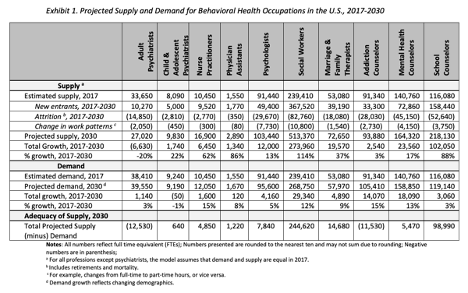Mental And Behavioral Health Workforce Overview

Did you know that:
- 80% of individuals with a substance use disorder do not get needed care
- 57% of those with mental illness also do not get needed care
- Nearly one-third of those living with serious mental illness do not get the care they need
As we can see from this 2019 National Survey on Drug Use and Health (NSDUH) data, people in our communities are not only suffering, but millions of Americans are facing mental health issues we as a nation must address.
Who Is Part of The Mental and Behavioral Health Workforce, What They Do and Their Work Environment?
The mental and behavioral health workforce consists of:
- Psychiatrists
- Psychologists
- Social workers
- Psychiatric nurse practitioners (PMHNP)
- Marriage and family therapists
- Certified prevention specialists
- Addiction counselors
- Mental health/professional counselors
- Psychiatric rehabilitation specialists
- Psychiatric aides and technicians
- Paraprofessionals in psychiatric rehabilitation and addiction recovery fields (e.g., case managers, homeless outreach specialists, or parent aides)
- Peer support specialists
- Recovery coaches and more
Their primary duties include:
- Diagnosing mental health conditions (i.e., anxiety, depression, grief, low self-esteem, stress, suicidal impulses etc.)
- Providing direction, treatment and counsel/therapy to individuals suffering with behavioral health challenges (i.e., mental illness, addiction, behavioral disorders etc.)
- Prescribing and monitor medications
- Teaching individual’s family members about mental and behavioral health disorders and helping them develop strategies to cope with those problems
- Referring individuals to resources and other services (i.e., food and housing assistance, job placement, support groups, etc.)
- Conducting outreach programs to help individuals identify the signs of mental and behavioral health problems and steps needed to recover
According to the U.S. Bureau of Labor Statistics, in 2019, substance abuse, behavioral disorder and mental health counselors held approximately 319,400 jobs. The largest employers included:
- Outpatient mental health and substance abuse centers (19%)
- Individual and family services (16%)
- State, local, and private hospitals (10%)
- Residential mental health and substance abuse facilities (10%)
- Government (8%)
Additionally, mental and behavioral health professionals tend to work in a wide range of settings such as prevention programs, community-based programs, inpatient treatment programs, employee assistance programs, primary care health delivery systems, emergency rooms, criminal justice systems, schools, higher education institutions among others.
Most work full-time. In some cases, they even work evenings, nights, and weekends.
Pay and Job Outlook
The annual median wage for substance abuse, behavioral disorder and mental health counselors was $47,660 in May 2020 – with the bottom 10% earning less than $30,590 and the highest 10% earning more than $78,700.
Employment in this area is expected to grow by 25% from 2019 to 2029 due to:
- Individuals continuing to seek addiction and mental health counseling services
- States seeking treatment and counseling services for drug offenders vs. jail time
- The continued need for counselors to work with military veterans and more
Candidates looking to enter this field should have their bachelor or master’s degree and should consider practicing in rural areas or underserved communities.
Mental and Behavioral Health Workforce Projections
The Health Resource and Services Administration (HRSA) publishes workforce projections that demonstrate the national supply of, and demand for, health professions by discipline.
According to its Health Workforce Simulation Model (HWSM), below are the national level supply and demand projections for behavioral health occupations from 2017-2030.

Here are some key findings:
By 2030, projected supply for behavioral health workers is the following:
- 20% decrease in supply of adult psychiatrists to 27,020
- 22% increase to 9,830 child & adolescent psychiatrists
- 62% increase to 16,900 nurse practitioners
- 86% increase to 2,890 physician assistants
- 13% increase to 103,440 psychologists
- 114% increase to 513,370 social workers
- 37% increase to 72,650 marriage & family therapists
- 3% increase to 93,880 addiction counselors
- 17% increase to 164,320 mental health counselors
- 88% increase to 218,130 school counselors
By 2030, projected demand for behavioral health workers is the following:
- 3% increase in demand for adult psychiatrists (to 39,550)
- 1% decrease in demand for child & adolescent psychiatrists (to 9,190)
- 15% increase in demand for nurse practitioners (to 12,050)
- 8% increase in demand for physician assistants (to 1,670)
- 5% increase in demand for psychologists (to 95,600)
- 12% increase in demand for social workers (to 268,750)
- 9% increase in demand for marriage & family therapists (to 57,970)
- 15% increase in demand for addiction counselors (to 105,410)
- 13% increase in demand for mental health counselors (to 158,850)
- 3% increase in demand for school counselors (to 119,140)
To be able to address and help the millions of Americans facing mental health issues, we must continue to build our mental and behavioral health providers.
Data like this is crucial for us as healthcare organizations, policymakers, stakeholders etc. to analyze and utilize when making decisions about behavioral health workforce education, training, and delivery of care.